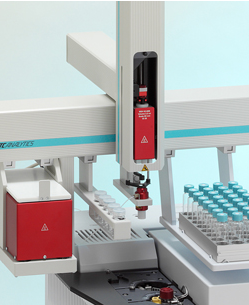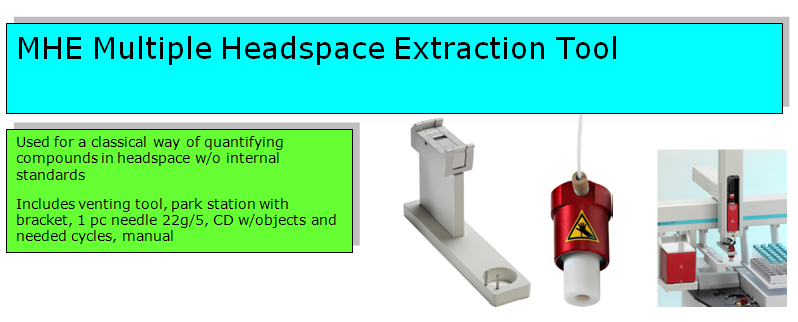Multi Headspace Extractions
From LEAP

| Multiple Headspace Extractions Option (MHE) |
| Application Type | |
| Standard Product | |
| Application ID | |
| Extend the headspace mode | |
| Description | |
| Accessory Showcase |
Contents |
Multiple Headspace Extractions Option (MHE)
The PAL Multiple Headspace Extraction (MHE) Option is an add-on module to extend the headspace mode of the LEAP CTC Analytics COMBI PAL Robot. In classical headspace technique one sampling is done per vial. The quantitative determination can be inaccurate in the presence of interfering matrices or in cases where a calibration standard cannot be made with the exact same matrix composition. The MHE option consists of a venting tool combined with a Park station. The MHE technique requires a series of sampling cycles using the same vial. First, a sample is pressurized to a specific pressure. The vial is then sampled and vented. The vial is re-pressurized and sampled again. This process is repeated multiple times to obtain final results.
MHE is generally regarded as one of the methods of choice with analysis of difficult headspace samples.Matrix effects are practically eliminated with MHE and the difficulties of quantitative headspace analysis can be overcome.
Multiple headspace extraction involves a sequence of pressurizing, sampling, and venting from the sample for each of the extraction steps. Traditionally, the pressurizing and venting steps are difficult to control with a syringe‐based system. A simple tool was manufactured, allowing for the controlled venting of the pressurized sample vial after each sample extraction step. The operation of the tool is fully integrated into the Chronos Mastersoftware used to control the COMBI PAL robot. The pressurization is done using the built‐in standard functions of the CombiPAL autosampler.
Photos
Notes
The PAL MHE Option requires PAL Firmware 3.0.X or higher. It can be controlled using PAL control software, the Chronos Mastersoftware,Cycle Composer, or any data system software that controls the PAL using the Cycle Editor for PAL ICC interpretation (e.g. Analyst, ChemStation, Empower, EZChrom, MassLynx, Xcalibur).
The multiple headspace technique is used in instances where interfering matrices interact with the analyte, such as by partial adsorption, or if a solid analyte contains moisture at a low concentration. Interfering moisture, for example, has a different vapor pressure from that of the analyte and would not allow classical quantitative determination using single point calibration. Whenever it is impossible to prepare the calibration standard using an identical matrix to that of the actual sample, single point calibration using static headspace technique will fail. The term multiple headspace extraction (MHE) is partially self-descriptive. To determine a quantity of analyte, sampling is carried out by repeat extraction of gas from the same vial space (known as the headspace) above a sample solution containing the analyte. The method thus approaches continuous gas extraction but is carried out step by step. The quantity of analyte in the sample can be calculated by performing consecutive analyses. In concept, the procedure is analogous to the multiple extraction of a sample from a simple elution column, where each passage of eluate through the column reduces the amount of analyte contained in a subsequent passage. Each peak area from each extraction is smaller than the previous peak. The sum of the peaks is proportional to the content of analyte. The mathematical relationship of one peak to the next here is exponential. A quantitative determination of the total amount of analyte present in a sample depends on the relationship between peak area and the amount of analyte. The sum of the amounts of analyte that are removed will come to equal the total amount of analyte in the original sample if the extractions are continued to infinity. Theoretically, summing the peaks from an infinite number of column extractions would allow calculation of the absolute amount of analyte in a sample. In practice, it is sufficient to carry-out a limited number of extractions, permitting a determination of the underlying exponential relationship between the measured area and the number of extractions, in turn allowing for the determination of the total amount of analyte in the sample. The effect of the sample matrix is eliminated by extracting the entire amount of the analyte. Contrary to the situation that exists in single-headspace extraction, it is therefore entirely possible to use calibration standards that are “not” prepared with the same matrix as the actual samples. For MHE to provide meaningful results, the only prerequisite is that equilibrium must exist with respect to the analytes in terms of the distribution between the phases in the headspace vial.
Typical steps the PAL takes:
- The syringe and Agitator are heated to required temperature.
- The vial is transported to the Agitator and equilibrium is established.
- The vial is pressurized by inserting the headspace syringe 22 mm into the vial. The flush gas is activated for a fixed time of 30 seconds.
- The headspace syringe needle is removed, plunger moved down and the flush gas stopped.
- A sample aliquot is taken according to the sample volume defined in the Sample List.
- The sample is injected into the GC.
- A counter is started to control the MHE cycles for the same vial.
- The MHE Tool is moved on top of the vial and pressed down. The MHE Tool needle is inserted 14 mm. The pressurized gas is vented to the atmosphere.
- The MHE Tool is parked and the Z-Axis is moved to Home Position. The equilibrium is re-established.
- The vial is pressurized a second time.
- A second sampling of an aliquot and injection to GC follows.
- The MHE counter is incremented and the vial is vented again. This cycle is repeated as often as defined by the MHE counter.
Downloads
The MHE technique is demonstrated with the CombiPAL, a syringe based autosampler. The quality of the data compares well with those obtained from a loop-based sampling system. Please see Poster:
![]() Poster on MHE by Tore Vulpius and Bruno Baltensperger
Poster on MHE by Tore Vulpius and Bruno Baltensperger
PRINT Function for Page
![]() PDF of this page formatted for printing
PDF of this page formatted for printing
Accessories for the PAL
![]() Other Accessories for PAL Robots
Other Accessories for PAL Robots
Videos of PAL
![]() LEAP's PAL Application Videos on YouTube
LEAP's PAL Application Videos on YouTube
LEAP strives to find total solutions for analytical lab automation by automating analytical processes for small and large molecules in extracted liquids, solids, and recently in human, animal and plant tissues. We provide the precise robotics and efficient sample prep required by modern measurement techniques such as MALDITOF mass spectroscopy. Our newest specialty customization of CTC Analytics PAL features small workstations that can perform complex liquid handling tasks including HPLC-Purification, SPE, filtration, weighing, heating and stirring. They can be configured as stand alone units or integrated for “just in time” sample prep for LC-MS or GC-MS analysis.
LEAP provides automated workstation instrumentation solutions based on the LEAP CTC PAL X, Y, Z syringe only autosampler robot from LEAP Technologies. This extremely flexible, precise, and adaptable liquid handling robotic platform is available in a variety of lengths and options depending on the requirements of your sample preparation and injections for your UHPLC, LC or GC chromatography.LEAP offers full support and service for the PAL platform in addition to being able to write custom macros, cycles, and scheduling to your applications. Please contact LEAP Technologies on how we can help you get maximized throughput with flexible pipetting automation solutions.
Contact LEAP
For additional information about LEAP and the PAL Platform, please contact LEAP Technologies. |








